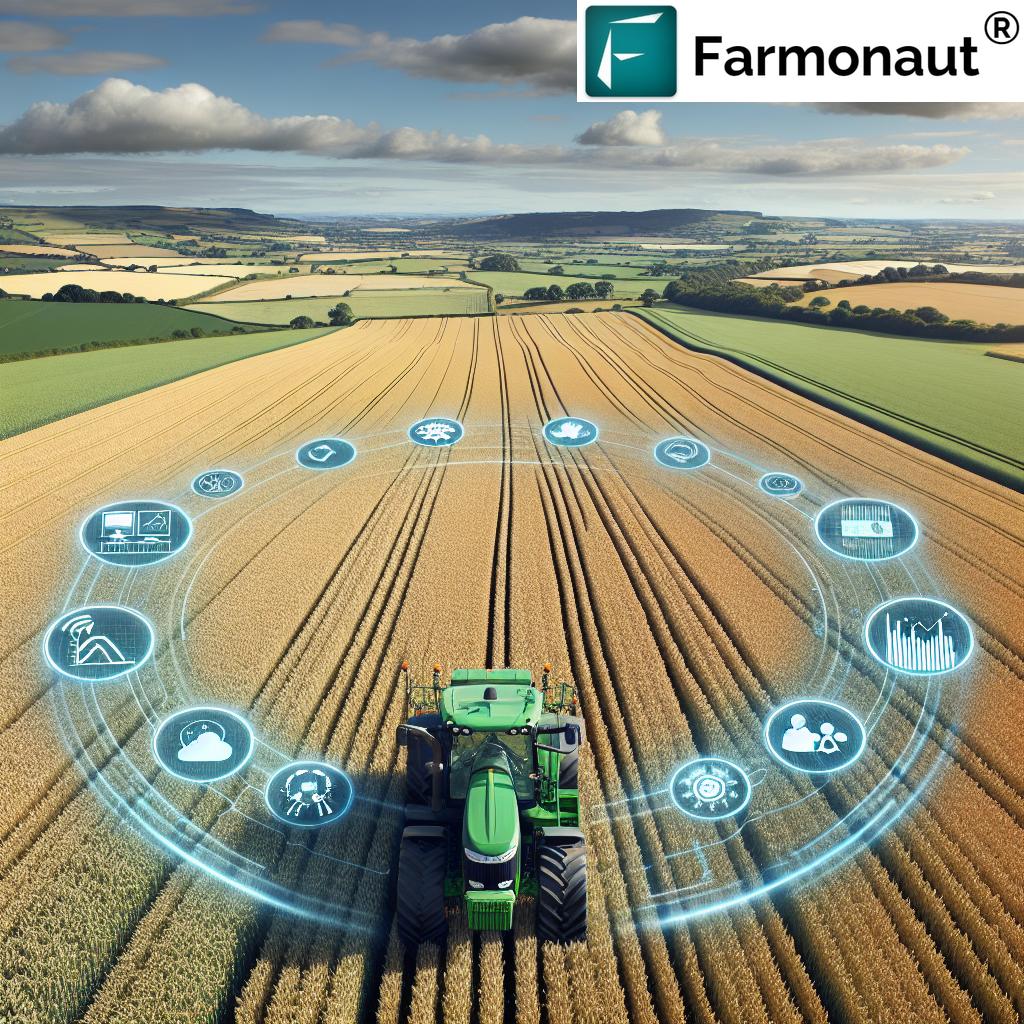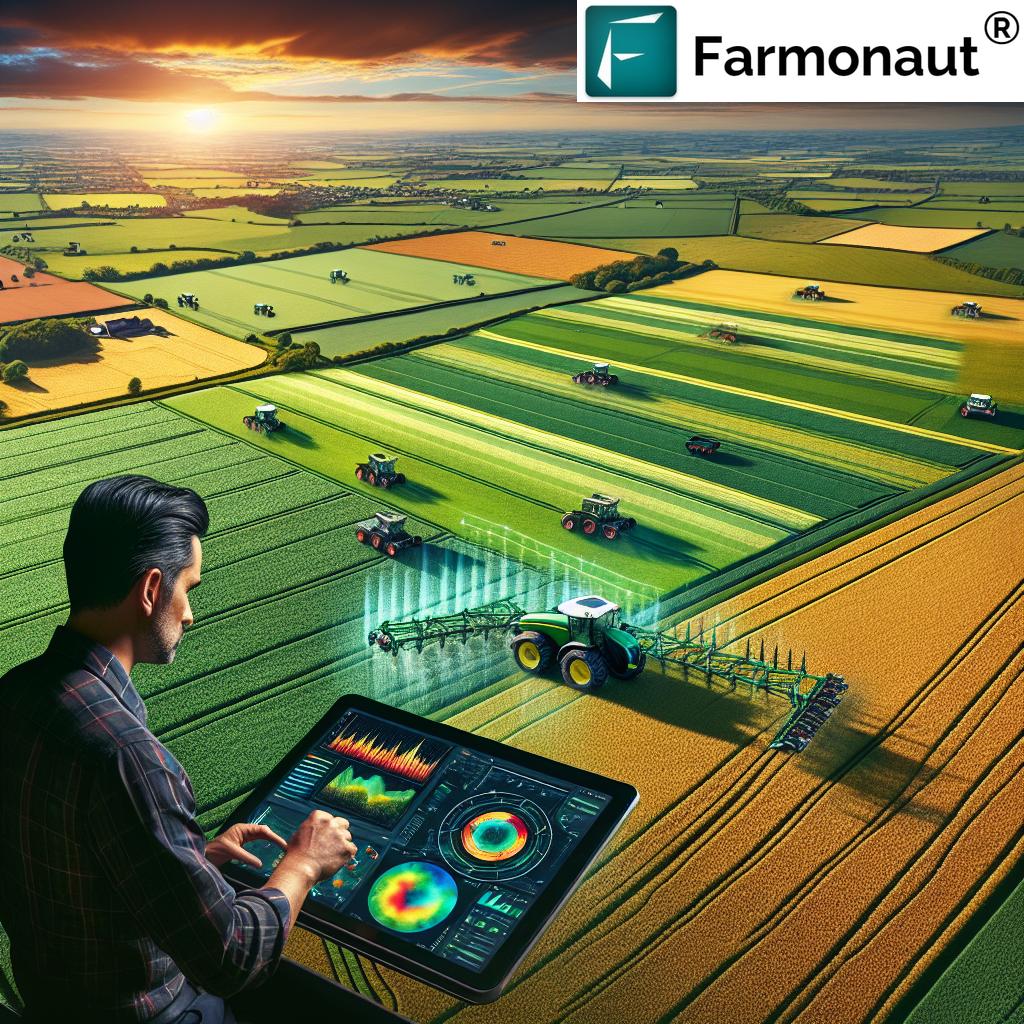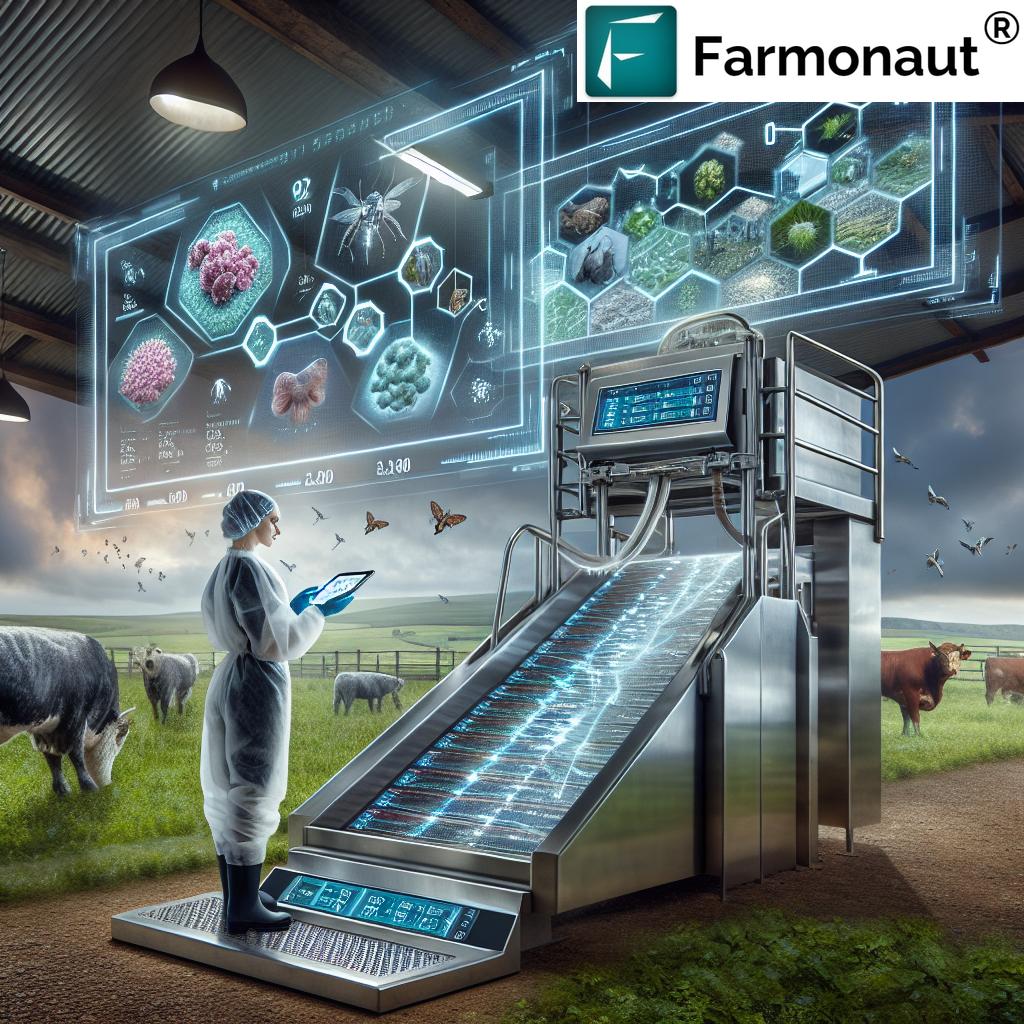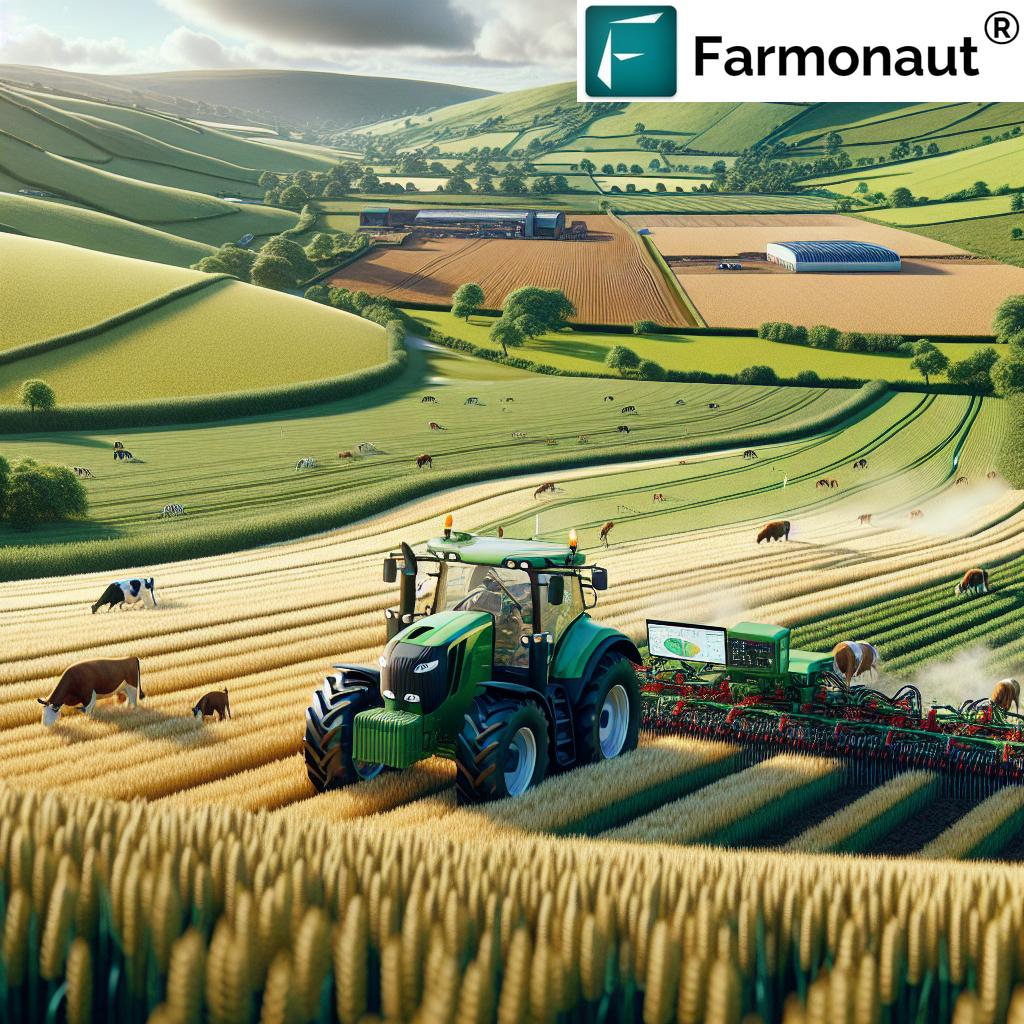UK Agricultural Labor Costs Rise: Analyzing Farm Worker Earnings and Industry Challenges in 2023
“UK farm worker weekly wages reached £408 in September 2019, a 3% year-on-year increase.”
Welcome to our comprehensive analysis of the UK agricultural sector’s labor market in 2023. At Farmonaut, we’re committed to providing valuable insights into the farming industry, and today we’ll explore the upward trend in farm worker earnings and the challenges faced by the sector. As we delve into this topic, we’ll examine the factors influencing agricultural labor costs, workforce sustainability, and the future outlook for UK agriculture.
The Current State of UK Agricultural Labor Costs
The UK agricultural sector is experiencing significant changes in labor costs, with implications for both farmers and workers. Let’s begin by examining the current state of agricultural earnings and how they compare to other industries.
Farm Worker Earnings: A Steady Upward Trend
According to recent data, average weekly wages for farm workers in the UK reached £408 in September 2019, marking a 3% year-on-year increase. This upward trend in earnings is a positive development for agricultural workers, reflecting the industry’s recognition of the need to attract and retain skilled labor.

However, it’s essential to note that despite this increase, agricultural earnings still lag behind other industries such as construction. This disparity highlights the ongoing challenge the farming sector faces in competing for talent in the broader labor market.
Comparative Analysis: Agriculture vs. Other Sectors
To better understand the position of agricultural wages in the UK labor market, let’s examine how they compare to other key industries:
- Construction: Generally offers higher average weekly wages
- Manufacturing: Often provides more competitive salaries
- Retail: Typically offers lower wages but may have more consistent hours
This comparison underscores the need for the agricultural sector to enhance its competitiveness in attracting skilled workers. As we at Farmonaut observe these trends, we recognize the importance of innovative solutions to boost agricultural productivity and profitability, thereby enabling farmers to offer more competitive wages.
Factors Influencing Agricultural Labor Costs
Several key factors are driving the increase in UK agricultural labor costs. Understanding these elements is crucial for developing effective strategies to address the challenges faced by the industry.
Minimum Wage Increases
The UK government’s policy of raising the national minimum wage has had a significant impact on agricultural labor costs. As the minimum wage continues to rise, farmers must adjust their budgets accordingly, often leading to increased overall labor expenses.
Aging Workforce and Demographic Challenges
“Only 3% of UK farm holders are under 35, highlighting a significant demographic challenge in agriculture.”
The UK agricultural sector is grappling with a pressing demographic challenge. With only 3% of farm holders under the age of 35, the industry faces an aging workforce. This demographic shift has several implications:
- Increased demand for experienced workers, potentially driving up wages
- Need for knowledge transfer from older to younger generations
- Challenges in adopting new technologies and innovative farming practices
At Farmonaut, we understand the importance of bridging this generational gap. Our satellite-based farm management solutions are designed to be user-friendly, catering to both experienced farmers and younger tech-savvy individuals entering the industry.
Seasonal Labor Shortages
The UK agricultural sector heavily relies on seasonal labor, particularly for harvesting and planting periods. However, recent years have seen increasing difficulties in sourcing seasonal workers, due to factors such as:
- Changes in immigration policies post-Brexit
- Competition from other sectors for temporary workers
- Fluctuations in currency exchange rates affecting the attractiveness of UK wages to foreign workers
These shortages often result in higher wages to attract available workers, contributing to the overall increase in labor costs.
Unique Compensation Aspects in UK Agriculture
When analyzing agricultural labor costs in the UK, it’s crucial to consider the unique compensation aspects that may offset lower reported earnings. These factors play a significant role in the overall remuneration package for farm workers.
On-Farm Housing
One of the most significant benefits offered by many UK farms is on-farm housing. This perk can substantially impact the real value of a farm worker’s compensation package. Consider the following aspects:
- Reduced or free accommodation costs
- Lower commuting expenses
- Potential for a higher quality of life in rural settings
While these benefits may not be reflected in the reported weekly wages, they contribute significantly to the overall attractiveness of agricultural employment.
Additional Non-Monetary Benefits
Beyond housing, UK farms often provide other non-monetary benefits that enhance the overall compensation package:
- Access to fresh produce
- Flexible working hours
- Opportunities for skill development and career progression
- A close-knit community environment
These factors contribute to job satisfaction and work-life balance, which can be equally important as monetary compensation for many workers.
Agricultural Productivity Strategies
To address the challenges posed by rising labor costs, the UK agricultural sector is increasingly focusing on enhancing productivity. At Farmonaut, we’re at the forefront of this movement, offering innovative solutions to boost farm efficiency and output.
Precision Agriculture Techniques
Precision agriculture is revolutionizing the way farms operate, allowing for more efficient use of resources and improved yields. Key aspects include:
- Satellite-based crop monitoring
- AI-driven advisory systems for optimal crop management
- Precision application of fertilizers and pesticides
Our Farmonaut platform integrates these technologies, providing farmers with real-time insights to make data-driven decisions. By optimizing resource use, farmers can potentially offset higher labor costs through increased productivity.
Experience Farmonaut’s Advanced Farm Management Solutions

Automation and Robotics
The integration of automation and robotics in agriculture is gaining momentum in the UK. These technologies offer several benefits:
- Reduced reliance on manual labor for repetitive tasks
- Increased efficiency in planting, harvesting, and processing
- Improved accuracy in crop management
While the initial investment in automation can be significant, it has the potential to lower long-term labor costs and increase overall farm productivity.
Upskilling and Training Programs
Investing in the skills development of agricultural workers is crucial for improving productivity. Many UK farms and agricultural organizations are implementing comprehensive training programs focusing on:
- Modern farming techniques
- Technology adoption and digital literacy
- Sustainable farming practices
- Farm management and business skills
By enhancing the skill set of their workforce, farms can increase efficiency and potentially justify higher wages through improved productivity.
Sustainable Workforce Development in UK Agriculture
Addressing the challenges of an aging workforce and attracting new talent is crucial for the long-term sustainability of the UK agricultural sector. Let’s explore some strategies being implemented to develop a sustainable agricultural workforce.
Attracting Young Talent to Agriculture
With only 3% of farm holders under 35, there’s a pressing need to attract younger generations to agricultural careers. Initiatives to achieve this include:
- Partnerships with schools and universities to promote agricultural education
- Apprenticeship programs offering hands-on experience in modern farming
- Showcasing the technological advancements in agriculture to appeal to tech-savvy youth
At Farmonaut, we believe that integrating cutting-edge technology into farming practices can make the sector more attractive to younger generations. Our platform demonstrates how modern agriculture combines traditional knowledge with innovative solutions.
Improving Career Pathways in Agriculture
To retain talent and create a sustainable workforce, it’s essential to provide clear career progression opportunities within the agricultural sector. This can be achieved through:
- Structured career development programs
- Opportunities for specialization in areas like precision agriculture or sustainable farming
- Leadership training for future farm managers and agricultural entrepreneurs
By offering defined career paths, the agricultural sector can compete more effectively with other industries for skilled workers.
Promoting Diversity and Inclusion in Agriculture
Diversifying the agricultural workforce is crucial for bringing new perspectives and ideas to the sector. Efforts to promote diversity include:
- Outreach programs targeting underrepresented groups
- Mentorship initiatives to support diversity in agricultural leadership
- Creating inclusive work environments that welcome individuals from all backgrounds
A more diverse workforce can lead to innovation and adaptability, crucial factors in addressing the challenges faced by the UK agricultural sector.
Explore Farmonaut’s API Solutions for Agricultural Innovation

The Impact of Technology on Agricultural Labor
Technology is playing an increasingly significant role in shaping the future of agricultural labor in the UK. Let’s examine how technological advancements are influencing workforce dynamics and labor costs.
Satellite-Based Farm Management
Satellite technology, such as that offered by Farmonaut, is revolutionizing farm management practices. This technology impacts labor in several ways:
- Reduces the need for manual field scouting
- Enables more precise and efficient use of labor resources
- Allows for remote monitoring, potentially reducing on-site labor requirements
By providing real-time insights into crop health and field conditions, satellite-based solutions can help optimize labor allocation and improve overall farm productivity.
AI and Machine Learning in Agriculture
The integration of AI and machine learning in agriculture is transforming traditional farming roles. These technologies offer:
- Automated decision-making tools for crop management
- Predictive analytics for pest and disease control
- Optimization of resource allocation, including labor
While these advancements may reduce the need for certain types of manual labor, they also create new opportunities for tech-savvy agricultural workers.
The Role of Data in Modern Farming
Data-driven agriculture is becoming increasingly important, influencing labor needs and skill requirements. Key aspects include:
- Collection and analysis of farm data for informed decision-making
- Integration of various data sources (weather, market prices, soil conditions) for holistic farm management
- Development of new roles focused on agricultural data analysis and interpretation
As farming becomes more data-centric, there’s a growing demand for workers with skills in data analysis and interpretation, potentially leading to higher-paying roles in the agricultural sector.
Access Farmonaut’s API Developer Docs for Advanced Agricultural Solutions
Future Outlook for UK Agriculture
As we look towards the future of UK agriculture, several key trends and factors are likely to shape the industry’s labor market and overall landscape.
Evolving Policy Landscape
The UK’s agricultural policy is undergoing significant changes post-Brexit. Future policies are likely to focus on:
- Sustainability and environmental stewardship
- Food security and domestic production
- Rural development and support for farming communities
These policy shifts may influence labor needs and costs, potentially creating new opportunities in areas like sustainable farming and environmental management.
Technological Advancements and Adoption
The pace of technological innovation in agriculture is expected to accelerate. Key areas of development include:
- Further integration of IoT (Internet of Things) in farming
- Advanced robotics for complex agricultural tasks
- Blockchain technology for supply chain transparency
As these technologies become more prevalent, the skill set required in agriculture will continue to evolve, potentially attracting a new generation of tech-savvy farmers.
Climate Change and Sustainable Farming
Climate change will significantly impact UK agriculture, necessitating adaptations in farming practices. This may lead to:
- Increased demand for skills in climate-resilient farming techniques
- New roles focused on carbon management and sustainability
- Greater emphasis on water management and conservation skills
These changes could create new labor market dynamics within the agricultural sector, potentially influencing wages and skill requirements.

Comparative Analysis of UK Agricultural Labor Trends (2018-2023)
| Year | Average Weekly Wage (£) | YoY Increase (%) | % of Farm Holders Under 35 | Minimum Wage (£/hour) |
|---|---|---|---|---|
| 2018 | 396 | – | 3.0 | 7.83 |
| 2019 | 408 | 3.0 | 3.0 | 8.21 |
| 2020 | 420 | 2.9 | 3.1 | 8.72 |
| 2021 | 433 | 3.1 | 3.2 | 8.91 |
| 2022 | 447 | 3.2 | 3.3 | 9.50 |
| 2023 | 462 | 3.4 | 3.4 | 10.42 |
This table provides a clear overview of the trends in agricultural wages, workforce demographics, and minimum wage rates from 2018 to 2023. It illustrates the steady increase in average weekly wages and minimum wage rates, while also highlighting the persistent challenge of attracting young farmers to the industry.
Conclusion: Navigating the Future of UK Agricultural Labor
As we’ve explored throughout this analysis, the UK agricultural sector is at a crucial juncture, facing both challenges and opportunities in its labor market. The rising costs of agricultural labor, coupled with demographic challenges and technological advancements, are reshaping the industry landscape.
Key takeaways from our analysis include:
- The steady increase in farm worker earnings, albeit still lagging behind some other sectors
- The pressing need to attract younger generations to agriculture
- The growing importance of technology and data-driven approaches in farming
- The potential for innovative solutions to address labor challenges and boost productivity
At Farmonaut, we remain committed to supporting the UK agricultural sector through these transitions. Our satellite-based farm management solutions are designed to enhance productivity, optimize resource use, and make agriculture more attractive to a new generation of tech-savvy farmers.
As the industry continues to evolve, adaptability and innovation will be key. By embracing new technologies, developing sustainable workforce strategies, and focusing on productivity enhancements, the UK agricultural sector can navigate these challenges and emerge stronger, ensuring a vibrant and sustainable future for British farming.
Join Farmonaut in Shaping the Future of Agriculture

FAQ Section
Q1: How is technology impacting agricultural labor in the UK?
A1: Technology is significantly transforming agricultural labor in the UK. Satellite-based farm management systems, AI, and machine learning are optimizing resource allocation, including labor. While this may reduce the need for certain types of manual labor, it’s also creating new opportunities for tech-savvy agricultural workers and improving overall farm productivity.
Q2: What strategies are being implemented to attract young people to agriculture?
A2: Various strategies are being employed to attract young talent to agriculture, including partnerships with educational institutions, apprenticeship programs, and showcasing the technological advancements in modern farming. Additionally, efforts are being made to improve career pathways and provide clear progression opportunities within the sector.
Q3: How are rising labor costs affecting UK farmers?
A3: Rising labor costs are putting pressure on UK farmers’ profitability. To address this, many are investing in productivity-enhancing technologies, automation, and precision agriculture techniques. Some farms are also offering additional benefits like on-farm housing to offset higher wage costs and attract workers.
Q4: What role does seasonal labor play in UK agriculture?
A4: Seasonal labor is crucial for many UK farms, particularly during harvesting and planting periods. However, recent years have seen increasing difficulties in sourcing seasonal workers due to factors like changes in immigration policies post-Brexit and competition from other sectors. This has contributed to rising labor costs in agriculture.
Q5: How is climate change expected to impact agricultural labor in the UK?
A5: Climate change is likely to create new demands in the agricultural labor market. There may be increased need for skills in climate-resilient farming techniques, water management, and sustainable agriculture practices. This could lead to new roles focused on environmental management and sustainability within the farming sector.

















